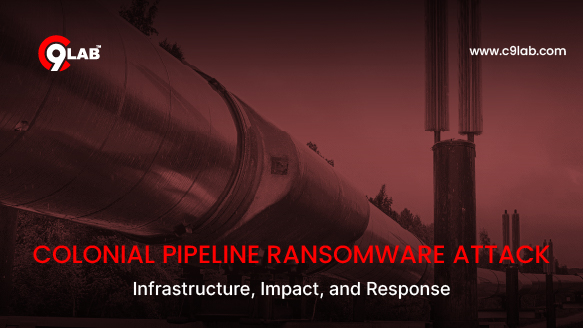Abstract
This case study provides a detailed analysis of the 2021 ransomware attack against Colonial Pipeline, a critical infrastructure entity. The report synthesizes publicly available information from government advisories, legal documents, and reputable media to examine the tactical failures, the crisis management dilemma of ransom payment, and the subsequent shift in national cybersecurity policy for critical infrastructure. The focus is on lessons learned regarding third-party password reuse, network segmentation, and public-private response coordination.
Executive Summary
A cybercriminal group, DarkSide, deployed ransomware on the business networks of Colonial Pipeline, the largest fuel pipeline in the United States. The attack, originating from a single compromised VPN password lacking multi-factor authentication (MFA), led the company to proactively shut down pipeline operations for six days to prevent spread to operational technology (OT) systems. This caused widespread fuel shortages and panic buying across the U.S. East Coast. Colonial Pipeline paid a $4.4 million ransom. A coordinated FBI investigation resulted in the recovery of a significant portion of the funds. The incident directly triggered new mandatory cybersecurity directives for pipeline operators from the Transportation Security Administration (TSA).
Scope and Ethical Constraints
This document contains only information from public sources, including U.S. government releases, court documents, and statements from involved parties. No non-public or classified information is included.
Background (Why This Matters)
The Colonial Pipeline attack was a watershed moment that demonstrated how a cyberattack on a single critical infrastructure node could inflict national-level economic and societal disruption. It forced a reckoning on the resilience of privately-owned essential services and the role of government in regulating their cybersecurity posture.
Incident Summary
Date of Detection: May 7, 2021
Impacted Organization: Colonial Pipeline Company (Critical Infrastructure – Energy Sector)
Initial Finding: Ransomware encryption on business IT systems, disrupting the systems used for managing pipeline logistics, invoicing, and scheduling. A ransom note was discovered.
Immediate Action: Colonial Pipeline proactively shut down all pipeline operations to contain the threat. The FBI and CISA were engaged. A ransom of 75 Bitcoin (~$4.4M) was paid to the attackers.
Methodology — Attack Chain & Analysis
The attack lifecycle can be broken down into four critical phases, highlighting key security failures.
Initial Access:
Vector: Compromised Virtual Private Network (VPN) account.
Cause: The account password was discovered in a batch of leaked credentials on the dark web. The account lacked Multi-Factor Authentication (MFA), providing unfettered access.
Lateral Movement & Data Exfiltration:
Attackers moved laterally from the initial entry point through the corporate network.
Over 100 GB of data was exfiltrated for double-extortion leverage.
Impact & Business Disruption:
Ransomware was deployed, encrypting critical business IT systems.
Fear of lateral movement into Operational Technology (OT) networks prompted a full, precautionary shutdown of pipeline operations—the primary impact vector.
Monetization & Response:
A ransom was paid to obtain a decryption tool and prevent the publication of stolen data.
The U.S. Department of Justice later seized approximately $2.3 million of the paid ransom from the attackers’ cryptocurrency wallet.
Timeline
| UTC Timestamp | Event | Source/Evidence |
| May 6, 2021 | Initial compromise via compromised VPN credential. | DOJ Affidavit, Company Statement |
| May 6-7, 2021 | Lateral movement and data exfiltration (~100 GB). | Incident Response Reports |
| May 7, 2021 | Ransomware deployed. Colonial Pipeline shuts down all operations. | Public Company Announcement |
| May 9, 2021 | Colonial Pipeline pays ~$4.4M ransom. The White House declares state of emergency. | Court Documents, White House Briefing |
| May 12, 2021 | Pipeline operations gradually restarted. | Public Company Announcement |
| June 7, 2021 | DOJ announces recovery of $2.3M of the paid ransom. | DOJ Press Release |
Findings
Critical Failure in Basic Cyber Hygiene: The absence of Multi-Factor Authentication (MFA) on a critical remote access point was the primary technical failure that enabled the breach.
Inadequate IT/OT Segmentation: The lack of robust segmentation between corporate IT and operational OT networks meant a business network incident could force a catastrophic physical shutdown.
The Ransom Dilemma for Critical Infrastructure: The incident highlights the intense pressure on critical infrastructure operators to pay ransoms to restore essential services, despite official guidance against it.
Policy Catalyst: The attack served as a direct catalyst for the TSA’s new security directives, mandating cybersecurity requirements for U.S. pipeline operators for the first time.
Remediation Steps Taken (Summary)
Mandated implementation of MFA for all remote access and critical systems.
Accelerated projects to enforce robust network segmentation between IT and OT environments.
Enhanced 24/7 security monitoring and endpoint detection.
The TSA issued Security Directive 2021-01 and 2021-02, requiring pipeline operators to report incidents, implement cybersecurity measures, and develop contingency plans.
Recommendations (For Critical Infrastructure)
Enforce MFA Universally: MFA is non-negotiable for all remote access and privileged accounts.
Architect for Segmentation: Implement and maintain strong logical and physical separation between corporate and operational networks.
Develop Crisis Playbooks: Have pre-established, tested incident response plans that include guidelines for engaging with law enforcement (FBI, CISA) and managing the ransom dilemma.
Engage Proactively with Government: Build relationships with sector-specific agencies (CISA, TSA) and law enforcement before an incident occurs.
Conclusion
The Colonial Pipeline attack was not a sophisticated technical exploit but a devastatingly effective one that exploited foundational security gaps. It underscores that the resilience of national critical infrastructure is dependent on the rigorous implementation of basic cybersecurity controls and well-practiced public-private response coordination.

